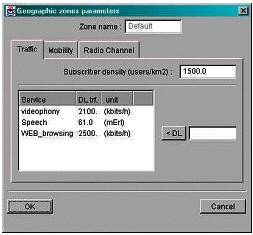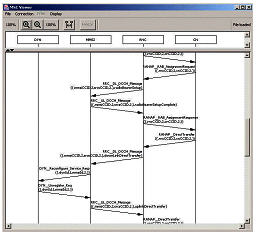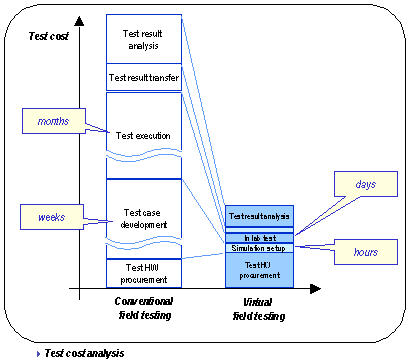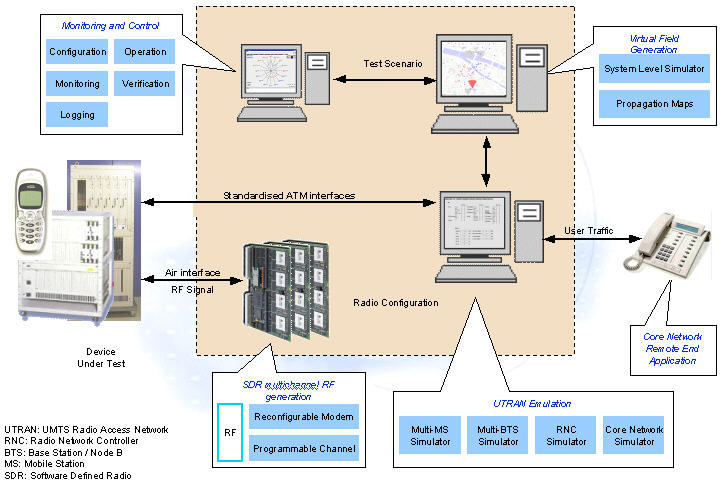|
|
A new
approach: the Virtual Field Test
The Virtual Field
Test™ approach recreates the field conditions directly in the
test lab (virtual reality), by combining accurate propagation
simulation with hybrid implementation. Test engineers can then create
various and significant traffic and mobility conditions, and therefore
give a consistent validation of the handsets or equipment, saving most
of the cost of real field trials.
This approach relies on
Dynamo, a real-time system level dynamic simulator for
emulating the whole UTRAN (UMTS Terrestrial Radio Access Network)
virtually deployed. It takes benefit of the Flexcell™
Software Defined Radio Platform to generate a sophisticated
combination of radio signals reproducing the interference conditions
of the field.
Features
-
Device testing within
a large set of mobiles (several thousands typically)
-
Generation of a large
number of cells (several 10s of Node Bs, typically)
-
Generation of near
real radio conditions (radio waves propagation maps)
-
Actual operation/deployment
cases import facilities
-
Dynamic generation of
mobile events and incoming/outgoing calls
-
Easy generation of
complex network simulation scenarios
-
Support of 3GPP
Release 99 FDD mode (W-CDMA)
-
Mobility and service
module editing tools
Technical
breakthrough
-
System Level
simulator generating real-time stimuli to the equipment under test
-
Protocol stacks
emulation with multiple contexts implementation
-
Programmable Multiple
Channel Simulator
-
SDR (Software Defined
Radio) technology for generation of complex composite radio signals
Virtual
Field Test™ applications
-
RNC testing
-
Node B testing
-
Mobile Station
testing
"Testing
by Rehearsal"
With Virtual Field
Test™, a test case associates "a scene" with
a set of simulation parameters: subscriber density, distribution of
mobility (pedestrian, vehicular, etc.), distribution of traffic (voice,
streaming video, packet). This set of parameters is customised for
each geographical area defined in the scenario (e.g. hot spots).

Put
the equipment on stage
Simulation events (e.g
handover) trigger message sequences, sent over the standardised
interfaces of the device under test. Then, it dynamically takes
appropriate actions in real-time, on the protocols carried over these
interfaces (e.g. RANAP, NBAP, ALCAP, RRC,…).

Business
significance of test results
During the test, three
monitoring tools display real-time indicators.
-
The Signalling
monitoring tool displays indicators linked to protocol management:
-
3GPP messages
load
-
Impact at system
level (memory, CPU)
-
Kiviat
representation of messages flow for the different simulators
-
QoS monitoring
per traffic class (blocked calls, dropped calls, user
satisfaction rate)
-
History of the
different signalling messages throughput
-
The MSC viewer
monitors signalling flow of the mobile under test
-
The Virtual Field
monitoring tool displays indicators linked to radio conditions in
the system. They can be displayed either at system level (average
value) or at cell or radio link level:
-
Transmitted and
received power
-
Traffic load (UL
and downlink capacity)
-
Number of mobiles
in soft handover
-
Display of
real-time OVSF codes allocation per cell
Important
test cost/time reduction

Scenario
parameters (rather than tescase development)
No need for code
writing of testcases (TTCN, C code), just set up the scene via:
-
Mobility Models
-
Library containing
user-defined models
-
Speed, trajectory,
location constraints, graph oriented,…
-
Service Models
-
Library containing
user-defined models
-
Data rates,
asymmetry, session duration, QoS (Eb/Io), inactivity periods (DTX)
-
Dynamic traffic
mixes
-
Multiple
user-defined areas, each defining
-
Different Poisson
laws in each area for generation of new calls at each simulation
step
Business
case assessement (rather than test result post-processing)
With Virtual Field
Test™, it is easy to create a realistic situation in its whole
complexity. Each test provides a higher coverage and requires less
effort than with conventional testing :
-
Test scenario quick
and easy to custom
-
High and
significant test coverage
-
large number of
results/observations captured in a one-shot simulation
-
quick and efficient
analysis of consistent results
Virtual
Field Test Architecture

Software
platform
Flexcell™
hardware
platform
-
High performance SDR
platform based on the latest DSP and FPGA technology
-
High reliability cPCI
platform compatible with H.110 and PICMG 2.16 backplane
-
Wideband radio front
end with up to 2 receivers and one transmitter
-
Up to 950MHz of
discontinued bandwidth supported per system
-
30 Gbps high speed
bus for internal communication
-
Up to 64 frequency
channels per Digital Processing Board

|
|